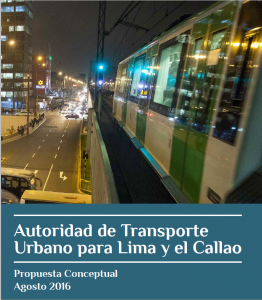TRANSPerú – Sustainable Urban Transport NAMA
The NAMA aims to reverse the trend towards car-dominated urban conglomerates, based on two main building blocks: the provision of high-quality public transport and the optimization of the vehicle fleet. In order to enable long term sustainable development, the NAMA focusses on the implementation of key structural changes:
- Improved political framework conditions (e.g. fuel economy standard, strengthening of vehicle homologation),
- Construction of public infrastructure (e.g. metro lines, optimized bus fleet, cycle lanes), and
- A strong institutional set-up (e.g. Single Transport Authority for Lima / Callao).
TRANS Peru’s core element is a policy matrix, used to plan and structure the sector transformation in a comprehensive manner. The matrix outlines objectives (outcomes), the actions required in order to achieve these objectives (outputs), and responsibilities for their implementation for the medium-term (2016 -2019).
The matrix was developed jointly in an intensive consultation process, including all stakeholders directly involved in shaping the sector’s policies, by means of the creation of an inter-institutional Steering Committee. As a result, the objectives of planned measures are coherent, planned actions are feasible, and the policy reform agenda counts with high backing and ownership of relevant stakeholders. The clear definition of specific and measurable outputs (and outcomes) further enables a sound monitoring and verification of the implementation of the NAMA.
TRANSPerú’s policy matrix foresees an overall of 77 outputs, which are clustered into six mitigation areas:
- Integrated public mass transport system in Lima / Callao: Construction of parts of Metro Line 2 (13.5 km) and Line 4 (8km), extension of the BRT line by 10.5 km, 12 intermodal integration spots, timetable and ticketing integration for BRT and Metro Systems,
- Non-motorized transport in Lima: Drafting of a Master Plan for non-motorized transport, revision and dissemination (with districts) of the outdated technical guidelines for NMT-infrastructure, mass awareness campaigns,
- Institutional development to improve urban transport management in Lima / Callao: Coordination agreement between Lima and Callao, process towards the establishment of a Single Transport Authority for Lima and Callao,
- Vehicle homologation and fuel efficiency for light vehicles: Implementation of a national vehicle homologation system including technical vehicle inspections, review of emission standards, and introduction of a fuel efficiency and CO2 emissions labelling scheme and standard, implementation of 30 NGV stations in 5 secondary cities,
- Modernization of the public transport vehicle fleet: Implementation of a scrapping scheme for Lima and Callao for routes competing with organized mass transport lines (replacement of 6000 old units by 1800 modern high capacity buses), development of scrapping schemes in secondary cities,
- Support to local governments to strengthen sustainable urban transport: Implementation of a Sustainable Urban Transport Policy and Programme that support secondary cities in the planning, financing and implementation of sustainable urban transport measures.
With the objective to present the Peruvian Sustainable Urban Transport NAMA “TRANSPerú” to a wider public at COP 20, the Steering Committee of the NAMA prepared an animated introductory video, explaining the NAMA’s approach. The video is available in Spanish and English language.
The TRANSfer project is run by GIZ and funded by the International Climate Initiative of the German Ministry for the Environment, Nature Conservation and Nuclear Safety (BMU).
Commissoning Agency: German Federal Ministry for the Environment, Nature Conversation and Nuclear Safety (BMU)
Budget: (German Contribution): 5.5 million EUROs
Duration: 10/2013-12/2016




